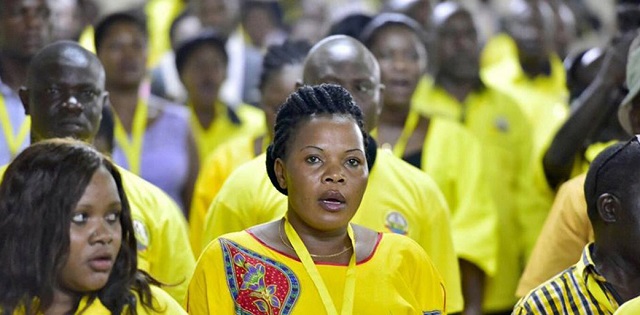
Comparing with Nyerere, Mandela
Some observers have compared Museveni’s current situation to that of the late former president of Tanzania Julius Nyerere when, during his last term from 1980-85, he sought to manage the leadership transition within the ruling Chama Cha Mapinduzi (CCM).
Nyerere was only 58 years old in 1980 when he started grooming his chosen successor, Seif Sharif Hamad, the renowned Zanzibari politician who was just 37 years old at the time. To pave way for Sharif Hamad, Nyerere pushed out another of his Zanzibari political allies, Aboud Jumbe Mwinyi who at the time was 60 years old and was president of Zanzibar until January 30, 1984. Despite Nyerere’s plans, however, it was Ali Hassan Mwinyi, who succeeded him. Mwinyi was 55 years old when he became president in 1985.
Observers also point at how Cyril Ramaphosa, who is said to have been groomed to succeed President Nelson Mandela in South Africa in 1999. Instead it was Thabo Mbeki, who emerged first as deputy president in 1996 and as Mandela’s successor three years later.
The point being made is that President Museveni will be 82 years old at the 2026 elections and might find challenges when yet another crop of young leaders emerge who do not share his ideological orientation or value his historical contribution as a liberation fighter.
Museveni, who will officially be 76-years old in 2021, is an ideologically driven politician who favours working with so-called ‘historicals’; people who have been by his side since the 1970s and 1980s during the bush wars that brought him to power or at least those like Kadaga and Mukula who he has worked with since he captured power in 1986.
This Museveni tendency to side-step official party structures might intensify as he seeks to work with his defeated comrades instead of the elected young Turks.
Museveni has appeared to be pushing this line following his move to create five slots for elders only in the next parliament. The elderly were also feted at an Older Persons Day for the first time ever in State House.
Speaking at the event, Museveni said “the NRM government cherishes the precious gift that the country has in its older persons”.
“I am glad that older persons will be represented in the 11th parliament as a special interest group,” he said.
Museveni also likes to show the public that he is physically and mentally fit. He takes long public walks, exercises at public functions and publishes videos of himself doing “40-something press ups.” He is also a keen dietician and likes to display his mental capacity via elaborate intellectual public lectures and write ups on various topics mainly political.
By ensuring that older persons remain visible, Museveni is also ensuring that he does not appear very different in a sea of youth in politics.
But his immediate lieutenants; 78-year old Vice President Edward Ssekandi, 72-year old Prime Minister Rugunda, and 81-year old First Deputy Prime Minister Moses and 85-year old second Deputy Prime Minister Ali Kivejinja appear spent. Even if Museveni insists on working with them or equally elderly people, it could further fracture the party and Museveni might find his position challenged.
Previous members of CEC
2005 to 2010
- Yoweri Museveni – National Chairman
- Moses Kigongo –First national vice chairman
- Rebecca Kadaga – Second national vice chairperson
- Matayo Kyaligonza – Vice chairman Western
- Mike Mukula – Vice chairman Eastern
- Francis Babu – Kampala
- Amama Mbabazi – Secretary General
- Adolf Mwesige – Legal advisor
- Kirunda Kivejinja – Chairman Historical Forum
2010 -2015
- Hassan Bassajjabalaba – chairman Entrepreneurs’ League
- Denis Namara – Youth
- Jacqueline Mbabazi – Women
- Dorothy Hyuha – Deputy Secretary General
- Singh Katongole – Deputy Treasurer
- Abdul Nadduli – Vice chairman Central
- Matayo Kyaligonza – Vice chairman Western
- Jim Muhwezi – Veterans
- Charles Bakabulindi – Workers
- Kabakumba Masiko – Institutions
- Fred Mukisa – Elderly
- Muhammad Nsereko–Kampala
- Nasur Gadaffi – NRM Youth League
Museveni has been challenged before.
In 2014 when President Yoweri Museveni chaired the NRM party’s CEC meeting in which he wanted Amama Mbabazi to relinquish the position of NRM Secretary General, it was Mbabazi and his wife Jacqueline who stood up against Museveni. Other CEC members were largely silent save for Matayo Kyaligonza who backed up Museveni. Museveni got wind of the former’s presidential ambition.
At the same time, to tighten his control over the NRM party, Museveni influenced the change of the party’s constitution to
allow him to appoint key NRM secretariat leaders including the secretary general and treasurer.
In 2015, after kicking Mbabazi out of the secretary general position and subsequently amending the party’s constitution, Museveni wanted to keep his old friend within CEC but the delegates rejected his proposal.
Instead the NEC delegates voted Prime Minister Ruhakana Rugunda; Kahinda Otafiire; Crispus Kiyonga; former deputy secretary general, Dorothy Hyuha and then Yumbe district Woman MP, Huda Oleru to sit. Museveni had wanted Mbabazi to be among these five. The Mbabazis were kicked out of NRM CEC. Mbabazi had served as the party’s inaugural secretary general since 2005.
Since it became a political party in 2005, the NRM CEC has had changes in some of the members like treasurer, secretary general and special interest group chairpersons but Museveni and Moses Kigongo have stayed put. In 2005 Chrispus Kiyonga was the party’s treasurer and was later replaced by Amelia Kyambadde but all these have since been replaced. Fred Mukisa who represented elders is also no longer a CEC member.
Much as the NRM CEC now has relatively young members, it is the old like Museveni and Kigongo who will insist on remaining in charge. But how long can they hold off?
****
 The Independent Uganda: You get the Truth we Pay the Price
The Independent Uganda: You get the Truth we Pay the Price


